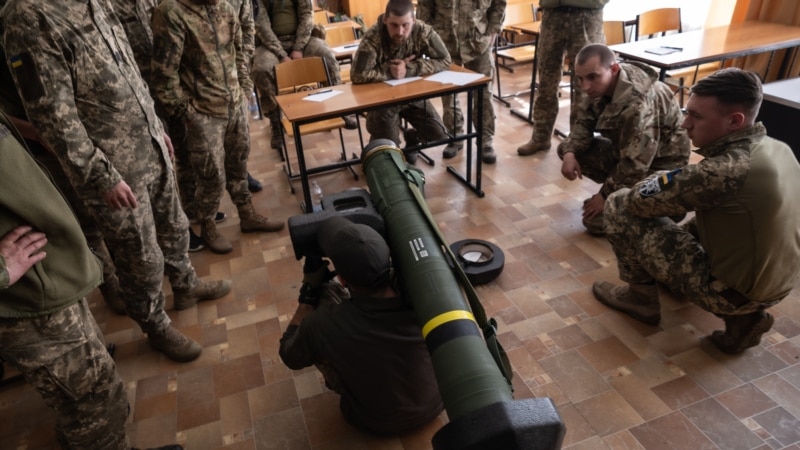Indian Media Misses the Mark – Anti-Tank Weapon in Mexican Cartel Hands is Not Javelins US Sent to Ukraine
On May 31, a Mexican cable news channel Milenio Television reported that a member of the drug trafficking Gulf Cartel had been recorded on video carrying the U.S. manufactured Javelin shoulder-fired anti-armor weapon, “which has been used during the invasion of Ukraine.”
Gulf Cartel is one of Mexico’s oldest criminal syndicates, it’s based in the city of Matamoros, Tamaulipas, directly across the border from the U.S. state of Texas.
Milenio Television aired footage of a cartel member carrying the alleged Javelin. The network said it picked the video from a social media platform, which it did not name. The channel did not specify whether it has verified the footage.
The All Source News Twitter account, which focuses on cartel violence in Mexico, said the video “was widely shared by multiple accounts that cover Tamaulipas.”
It identified the patch on the back of the cartel member carrying the weapon as the logo of Grupo Escorpion, the armed wing of the Gulf cartel.
News outlets, Russian broadcaster RT and Indian Firstpost among them, seized on the story claiming it proved that the weapon in the video was a Javelin and that it had been intended for, or smuggled out of, Ukraine.
The Firstpost headline read:
“US ‘Javelin’ misses mark: Anti-tank missile meant for Ukraine lands up with Mexican gangster.”
That is false.
It’s Firstpost and RT who missed the mark: the anti-tank weapon shown in the video isn’t a Javelin at all.
There is no evidence the alleged anti-tank weapon pictured in the Milenio Television report was ever intended for Ukraine or smuggled out of Ukraine to Mexico. There is also no evidence it came from U.S. military stocks.
The weapon shown in the broadcast appears to be an AT4 light anti-tank weapon, manufactured by Sweden’s Saab Bofors Dynamics, or an M136, a license-built copy of the AT4 widely used by the U.S. Army.
The Saab Bofors Dynamics media representative told Polygraph.info the company was unable to verify the weapon pictured in the news report, as the footage did not originate from them.
Military-Today.com said it is difficult to distinguish the M136 from the AT4, as “the appearance of the M136 is almost identical to the AT4.”
Ryan McBeth, an OSINT intelligence analyst, argues that the AT4 pictured in the video is “the equivalent of a movie prop.”
That’s because the AT4 pictured in the video bears a gold band, indicating it is a field handling trainer or “inert” training device that does not contain a live warhead.
AT4 is a word play on the caliber of the weapon — 84mm. The AT4 is a disposable, single-shot launcher, and unlike the Javelin, is unguided.
“[The AT4] is no substitute for the Javelin or NLAW guided-missile systems that take out main battle tanks. But it is easy to use and newcomers to the military can be trained on the weapon in little time,” Brent Eastwood, defense and national security editor for the 19FortyFive website, wrote in March 2022.
However, the Javelin launching system and missile can cost as much as $197,000 — making the AT4 a far cheaper, if less effective, alternative.
The United States has provided thousands of AT4s to Ukraine. So has Sweden.
But AT4s are used by militaries around the world, including countries in South America like Argentina, Brazil, Colombia and Venezuela.
In 2009, AT4s delivered to Venezuela ended up in the hands of the Revolutionary Armed Forces of Colombia (FARC), a Marxist–Leninist guerrilla group. The Colombian government seized those weapons.
Sweden asked the Venezuelan government how FARC rebels acquired those arms, which had end user-certificates certifying Venezuela as the final recipient.
Mexico’s drug cartels sought to acquire weapons like AT4s long before Russia invaded Ukraine in February 2022, and have previously been videoed carrying such arms.
Some social media users and media outlets identified the weapon in the Milenio Television report as an AT4, but misrepresented the report’s content, arguably to undermine U.S. support for Ukraine.
For example, the news aggregator Citizen Free Press tweeted:
“Mexican TV reports that dozens of U.S. AT-4 weapons systems, which were originally shipped to Ukraine, have been purchased by Cartel Golfo in Mexico.”
According to Twitter, that tweet has received 2.6 million views.
But Milenio Television never reported that weapons “were originally shipped to Ukraine.” Rather, it noted that such weapons had been shipped to Ukraine, just as they have been shipped to countries in South America.
RT’s report used uncertainty about the weapon’s make and origin to hammer home the Kremlin talking point that “nonexistent controls” on U.S. arms shipments to Ukraine “would result in the weapons ending up in the criminal underworld.”
But contrary to RT’s claim, the U.S. government has outlined the “concrete steps” it is taking “to counter threats posed by potential diversion of weapons in Eastern Europe.”
In May, a top European Commission official told Reuters the European Union had not seen large-scale “smuggling of firearms out of Ukraine.”
U.S. security assistance to Ukraine has been crucial in helping the country defend itself against Russia’s invading forces.
Ukrainian officials have fretted over the potential loss of U.S. support if those weapons ever ended up on the black markets.
This article has been archived for your research. The original version from Polygraph.info can be found here.




